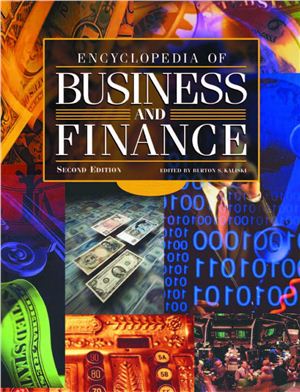Толковый словарь на английском языке по бизнесу и финансам.
Encyclopedia of business and finance / Burton S. Kaliski, editor-in-chief. — 2nd ed. 2007 -814 p.
Printed in the United States of America
Entries are arranged in alphabetical order. The Encyclopedia includes extensive crossreferencing
of two types: See and See Also references. See references fall within the
body of the work and refer the reader to articles diuscussing that topic. For example, if one
wanted to find information about bait-and-switch advertising and looked under Bait and
Switch, there would not be an article, but rather the instruction to SEE Ethics in Marketing;
Ethics in Law for Business; Govement Role in Business. See Also cross-references fall
at the end of articles and direct the reader to one or more other articles that may shed more
light on the topic. At the conclusion of the article on Insurance, for example, you will find
SEE ALSO Investments; Personal Financial Planning. At the end of Volume 2, there is an
extensive Index to terms and concept in the articles.
Is the knowledge contained in this work the definitive and final word on each topic?
The answer is most certainly not! In this day and age of dynamic and rapidly growing
knowledge, a positive answer would be quite inappropriate. However, this is not necessarily
a negative. The information contained in this edition of Encyclopedia of Business and Finance
is valid and reliable and enables readers to do further research by going to easily accessible
sources. Today’s technology offers a unique opportunity to extend one’s knowledge of every
topic presented, an opportunity not available so easily to previous generations.
This work was designed for different types of users. The middle school student may be
looking for a starting point for a paper on careers. The high school student may be seeking
background information on a major research topic, such as inteational trade. The business person may be seeking a summary of antitrust laws. The business teacher may be
preparing a lesson on the history of computing. The interested layperson may simply want
to lea something new about such topics as the No Child Left Behind legislation or investments.
Encyclopedia of business and finance / Burton S. Kaliski, editor-in-chief. — 2nd ed. 2007 -814 p.
Printed in the United States of America
Entries are arranged in alphabetical order. The Encyclopedia includes extensive crossreferencing
of two types: See and See Also references. See references fall within the
body of the work and refer the reader to articles diuscussing that topic. For example, if one
wanted to find information about bait-and-switch advertising and looked under Bait and
Switch, there would not be an article, but rather the instruction to SEE Ethics in Marketing;
Ethics in Law for Business; Govement Role in Business. See Also cross-references fall
at the end of articles and direct the reader to one or more other articles that may shed more
light on the topic. At the conclusion of the article on Insurance, for example, you will find
SEE ALSO Investments; Personal Financial Planning. At the end of Volume 2, there is an
extensive Index to terms and concept in the articles.
Is the knowledge contained in this work the definitive and final word on each topic?
The answer is most certainly not! In this day and age of dynamic and rapidly growing
knowledge, a positive answer would be quite inappropriate. However, this is not necessarily
a negative. The information contained in this edition of Encyclopedia of Business and Finance
is valid and reliable and enables readers to do further research by going to easily accessible
sources. Today’s technology offers a unique opportunity to extend one’s knowledge of every
topic presented, an opportunity not available so easily to previous generations.
This work was designed for different types of users. The middle school student may be
looking for a starting point for a paper on careers. The high school student may be seeking
background information on a major research topic, such as inteational trade. The business person may be seeking a summary of antitrust laws. The business teacher may be
preparing a lesson on the history of computing. The interested layperson may simply want
to lea something new about such topics as the No Child Left Behind legislation or investments.

